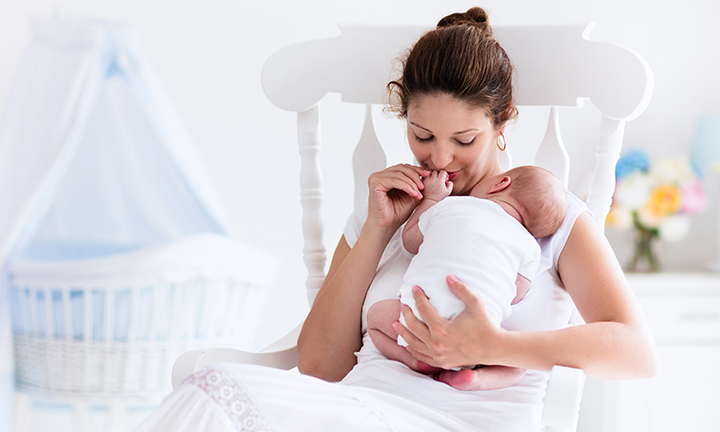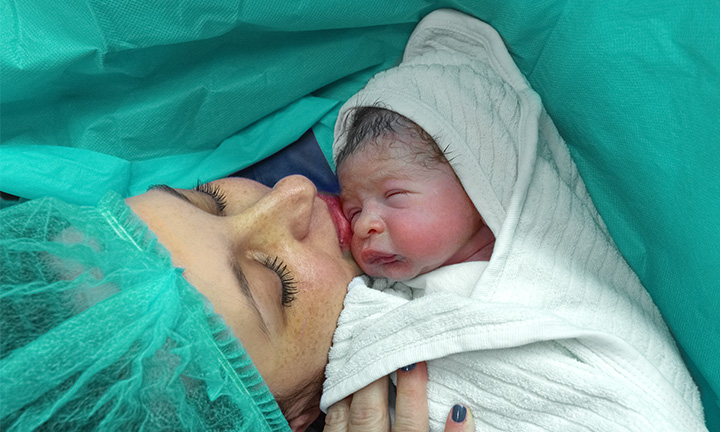
Vaginal Postpartum Bleeding: All About Lochia
5 min readUpdated October 09, 2020
5 min readUpdated October 09, 2020
Your body has been through so many changes during your pregnancy and childbirth, but there’s still a lot going on even after your little one’s birth as your body recovers and adapts during the postpartum period. Postpartum bleeding, known as lochia, is a natural part of this healing process. Read on to learn about the stages of lochia, how long bleeding after birth can last and when you might need to see a doctor about the blood loss.
What Is Postpartum Bleeding?
Postpartum bleeding usually refers to vaginal discharge after giving birth. The discharge itself is known as lochia, and it mostly consists of blood, mucous and placental tissue.
What is happening is this: Your uterus is shedding (and replacing) the lining that has helped keep your little one safe and snug during his or her stay in your belly.
Postpartum bleeding may seem a bit alarming at first, but it’s a perfectly normal part of recovering after giving birth [healing]. In the first few weeks after giving birth you may also feel cramps in the area of your uterus, known as ‘after pains’.
You’ll experience postpartum bleeding after both a vaginal birth and a caesarean section.
How Long Does Postpartum Bleeding Last?
The duration of postpartum bleeding is different for every mum. Sometimes it can last a couple of weeks, sometimes a month or longer. Generally speaking, the lochia stops flowing after about two to six weeks.
What Does Lochia Look Like?
The colour and amount of lochia discharge changes with time, starting out red or brownish before briefly darkening and then getting progressively lighter (and decreasing in amount) as the days and weeks go by.
Here’s what the bleeding might look like on a maternity sanitary towel during the postpartum period:
Lochia Colour Guide*
*The colour and quantity of postpartum bleeding can vary. This guide is not suitable for diagnosis. Always consult your doctor, midwife or health visitor if you have any concerns.
How Much Bleeding is Normal After Pregnancy?
On the first day after giving birth, you can expect to see quite heavy postpartum bleeding. It’s common to go through several soaked sanitary maternity pads in the first 24 hours.
You may also pass one or two larger (plum or tomato-sized) blood clots, or several smaller (grape-sized) ones in the first day. These are usually nothing to worry about – but tell your midwife or doctor about them to be on the safe side.
The precise quantities of postpartum bleeding can vary between mums, but after the first day the amount of bleeding after birth should decrease as time passes.
A typical progression could look like this:
Keep in mind that although the amount of bleeding goes down with time, some things can cause the amount of discharge to increase periodically before decreasing again. These include:
Is it Normal for Postpartum Bleeding to Stop and Start Again?
Lochia normally decreases gradually as time passes. The amount of discharge may vary a little between each change of sanitary pad, and after a couple of weeks there might be intermittent periods of little or no discharge.
However, the overall tendency should be a reduction. If you notice a fresh red discharge after postpartum bleeding has decreased or stopped, this is unlikely to be your lochia coming back.
One possible reason for fresh bleeding could be your period returning. If you feed your baby exclusively or partially with formula, this could happen as soon as five to six weeks after giving birth.
If you’re breastfeeding your period will usually (but not always) start later than this, as the hormones that triggers breast milk production can stop your body producing the hormones that regulate your menstrual cycle.
If you experience fresh bleeding after your lochia has subsided, it’s best to tell your health visitor or doctor, especially if you’re unsure what might be causing it.
What Should You Do When You Have Postpartum Bleeding?
When experiencing postpartum bleeding, follow these simple guidelines to stay comfortable and help prevent infections:
When Should You See a Doctor?
Every new mum has some postpartum bleeding and it’s usually nothing to worry about; but sometimes it’s best to check in with your doctor, midwife or health visitor. In rare cases you may need more urgent treatment.
In these cases, it’s helpful to keep the sanitary pads and/or any blood clots to show whoever will be examining you.
Tell your doctor, midwife or health visitor immediately if you experience any of the following:
If you have constant, bright red bleeding
Call 999 or go to your nearest A&E department immediately if you experience a constant flow of bright red bleeding at any time between 24 hours and 12 weeks after giving birth. This may be a postpartum haemorrhage (PPH). Although quite rare, a postpartum haemorrhage can be serious (and sometimes life-threatening) if it isn’t dealt with as soon as possible.
The Big Picture
Postpartum bleeding may be a bit of a hassle at first, but it’s just part of your body’s natural recovery mechanism after performing its miracle of bringing a new life into the world.
If you already have some maternity pads stashed away in your hospital bag, you’ll be well-prepared for this challenge.
The lochia will subside soon enough, but by then you’ll probably be too busy getting to know your newborn baby to even notice and the hassle associated with changing maternity pads will be a distant memory.
How we wrote this article
The information in this article is based on the expert advice found in trusted medical and government sources, such as the National Health Service (NHS). You can find a full list of sources used for this article below. The content on this page should not replace professional medical advice. Always consult medical professionals for full diagnosis and treatment.
The information in this article is based on the expert advice found in trusted medical and government sources, such as the National Health Service (NHS). You can find a full list of sources used for this article below. The content on this page should not replace professional medical advice. Always consult medical professionals for full diagnosis and treatment.
Read more about Newborn Baby
Related Articles
Join Pampers Club and get:







